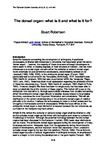The dorsal organ: what is it and what is it for?
| dc.contributor.author | Robertson, S. | |
| dc.date.accessioned | 2019-05-15T16:11:54Z | |
| dc.date.available | 2019-05-15T16:11:54Z | |
| dc.date.issued | 2013 | |
| dc.identifier.citation |
Roberston, S. (2013) 'The dorsal organ: what is it and what is it for?', The Plymouth Student Scientist, 6(1), p. 412-433. | en_US |
| dc.identifier.issn | 1754-2383 | |
| dc.identifier.uri | http://hdl.handle.net/10026.1/14025 | |
| dc.description | Scientific literature concerning the development of arthropods, in particular crustaceans, is littered with references to structures that have been given the name ‘dorsal organ’. However, the majority of these structures although homologous in name seem to differ, to varying degrees, in their structure or function. The two main references to a dorsal organ concern either the cuticular or sensory dorsal organ found externally on post-embryonic crustaceans, predominantly worked on by Laverack (1988, 1990, 1992), or the embryonic dorsal organ (Fioroni, 1980) particularly well documented in the Peracarida (Strömberg, 1972; Meschenmoser, 1989; Martin & Laverack, 1992) but also documented within the Hexapoda (Tiegs, 1942; Jura, 1967). There has been much speculation regarding the probable function of these two structures (e.g. Fioroni, 1980; Martin & Laverack, 1992; Aladin & Potts, 1995). However, despite this there has been no single study that has been able to state conclusively the entire function of these organs. This review will focus on the embryonic form and aims to, through accumulated evidence from studies concerning either the embryonic dorsal organ directly or studies closely related to its probable functions, condense the most important information and conclusions. This will aid clarification of the current understanding of the embryonic dorsal organ, in relation primarily to its function. I believe this is necessary in order to further understand the ontogeny of homeostatic control in crustaceans. While the focus will be on the embryonic dorsal organ a clear distinction is needed between the two structures, as confusion in the literature may have arisen... | en_US |
| dc.language.iso | en | en_US |
| dc.publisher | University of Plymouth | |
| dc.rights | Attribution 3.0 United States | * |
| dc.rights.uri | http://creativecommons.org/licenses/by/3.0/us/ | * |
| dc.subject | dorsal organ | en_US |
| dc.subject | arthropods | en_US |
| dc.subject | Crustacea | en_US |
| dc.subject | Hexapoda | en_US |
| dc.subject | amphipods | en_US |
| dc.title | The dorsal organ: what is it and what is it for? | en_US |
| dc.type | Article | |
| plymouth.issue | 1 | |
| plymouth.volume | 6 | |
| plymouth.journal | The Plymouth Student Scientist |



